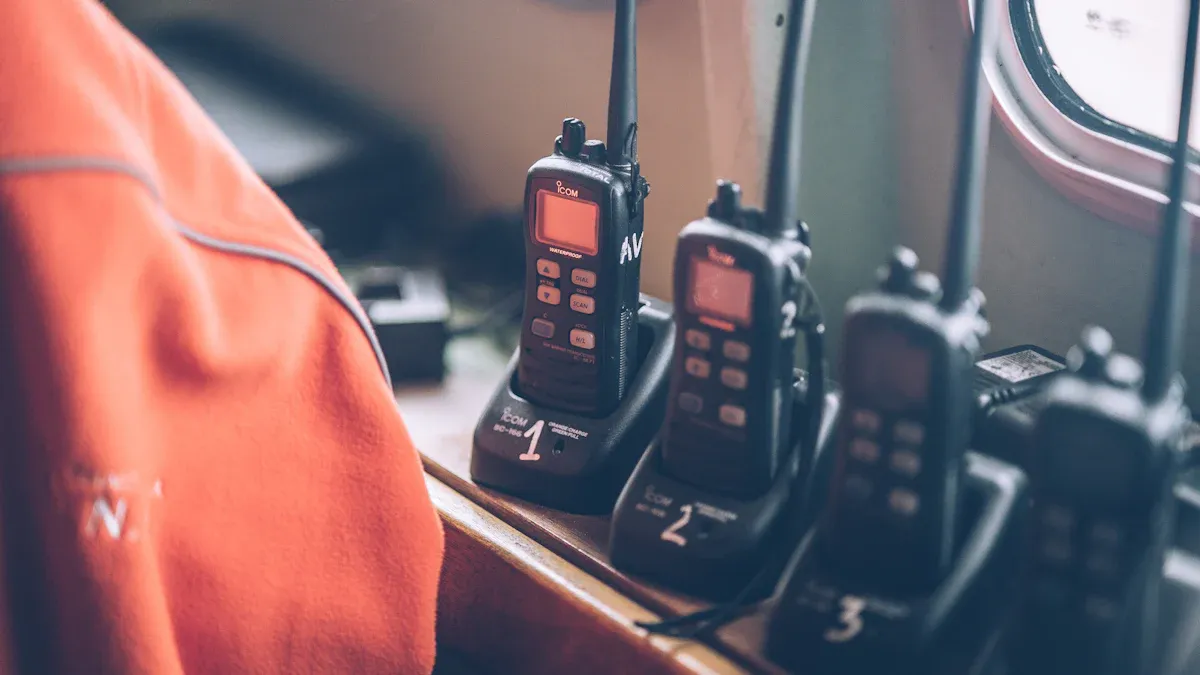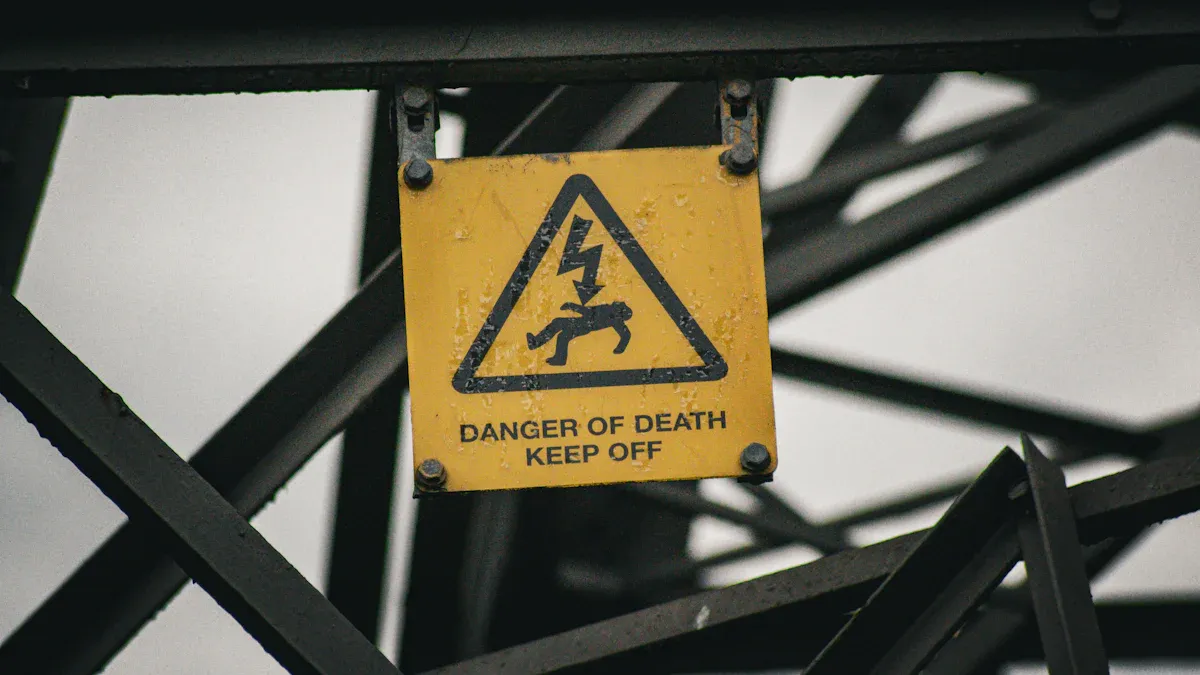
Hazardous locations, such as industrial plants or mining sites, demand robust communication systems to ensure safety. An emergency Explosion Proof Telephone prevents accidents by eliminating the risk of igniting flammable gases. Devices like the ATEX Explosion Proof Telephone meet stringent safety standards. In extreme conditions, an Outdoor waterproof telephone or a mining Explosion Proof Telephone offers durability and reliability.
What Are Explosion-Proof Telephones?

Definition and Purpose
Explosion-proof telephones are specialized communication devices designed to operate safely in environments where explosive gases, vapors, or dusts are present. Their primary purpose is to prevent ignition of hazardous substances while ensuring reliable communication during emergencies. These telephones comply with stringent safety certifications, such as ATEX and IECEx, which validate their ability to function in explosive atmospheres.
Note: Explosion-proof telephones are not limited to industrial use; they also cater to sectors like mining, oil and gas, and chemical manufacturing, where safety is paramount.
A closer look at their technical aspects reveals their versatility:
| Aspect | Description |
|---|---|
| Safety Certifications | Compliance with ATEX and IECEx standards ensures safety in explosive atmospheres. |
| Technological Advancements | Integration with digital communication tools enhances real-time data sharing and collaboration. |
| Design and Aesthetics | Customizable options improve workplace morale while maintaining safety and functionality. |
| Price Sensitivity | Competitive pricing is crucial for small to medium-sized enterprises balancing safety and costs. |
| Sustainability | Demand for eco-friendly products is rising due to tighter environmental regulations. |
Key Features
Explosion-proof telephones incorporate advanced features that distinguish them from standard communication devices. Recent technological studies highlight their robust construction, which includes thick steel housing to prevent explosions. Internal components are securely positioned to eliminate heat or spark generation, ensuring safe operation in hazardous environments.
These telephones also feature highly effective sealing mechanisms that protect against dust, liquids, and pollutants. This sealing capability ensures stable environmental conditions inside the device, making it suitable for extreme outdoor applications. For instance, an emergency Explosion Proof Telephone used in mining operations can withstand harsh conditions while maintaining functionality.
How They Differ from Standard Telephones
Explosion-proof telephones differ significantly from standard telephones in terms of design, safety performance, and durability. While standard telephones are designed for general use, explosion-proof models are tailored for hazardous areas, offering enhanced protection and reliability.
| Feature | Explosion-Proof Telephones | Standard Telephones |
|---|---|---|
| Designed for hazardous areas | Yes | No |
| Certification standards | Specific to explosive environments | None |
| Sealing performance | High (P66 waterproof) | Variable |
| Durability | Enhanced | Standard |
| Functionality | Basic talking functions | Basic talking functions |
Explosion-proof telephones prioritize safety and compliance, making them indispensable for industries where the risk of explosions is high. Their specialized design ensures uninterrupted communication, even in the most challenging conditions.
How Do Explosion-Proof Telephones Ensure Safety?
Specialized Design and Construction
Explosion-proof telephones are meticulously engineered to prevent the ignition of flammable substances in hazardous environments. Their specialized design incorporates features such as reinforced seals and gaskets, which block the entry of dust, water, and other contaminants. These seals also prevent the escape of sparks or heat that could ignite explosive materials.
The construction of these devices ensures durability and reliability under extreme conditions. For instance, they can withstand both high and low temperatures, making them suitable for environments like oil rigs or mining sites. Additionally, the design minimizes the risk of static electricity build-up, further reducing the chances of accidental ignition.
Key features of their design include:
- Specialized seals to prevent ignition of flammable materials.
- Resistance to extreme temperatures, ensuring functionality in harsh conditions.
- Anti-static components to mitigate ignition risks.
These design elements make explosion-proof telephones indispensable for industries where safety is a top priority.
Certifications and Standards
Explosion-proof telephones adhere to rigorous certifications and standards to ensure their safety and reliability. These certifications validate that the devices meet international safety requirements for hazardous locations.
| Certification/Standard | Region | Description |
|---|---|---|
| UL and CSA | North America | Certification for explosion-proof devices based on rigorous testing. |
| ATEX | Europe | Ensures equipment meets health and safety requirements for explosive atmospheres. |
| IECEx | Global | Provides a benchmark for compliance with international safety standards. |
| NEC | United States | Guidelines for explosion-proof equipment and hazardous location classifications. |
| NFPA | United States | Prescribes protective measures to mitigate risks in hazardous environments. |
These certifications, such as ATEX and IECEx, are critical for industries like mining and chemical manufacturing. They ensure that devices like the emergency Explosion Proof Telephone comply with safety regulations, reducing the risk of accidents. Failure to use certified equipment can result in severe penalties or catastrophic incidents.
Materials and Components for Durability
The materials used in explosion-proof telephones are carefully selected to enhance their durability and safety. Stainless steel and other robust materials are commonly used for the outer casing, providing resistance to corrosion and physical damage. This ensures that the devices remain operational even in harsh environments.
Internal components are designed to prevent the generation of sparks or excessive heat. For example, the wiring and circuits are insulated to eliminate ignition risks. Additionally, these telephones often feature ingress protection ratings like IP67 or IP68, which indicate resistance to dust and water.
| Metric | Description |
|---|---|
| Compliance with safety standards | Ensures that devices meet international safety regulations such as ATEX, CSA, IECEx, and UL. |
| Ingress protection ratings | Ratings like IP67 and IP68 indicate resistance to dust and water, enhancing reliability. |
| Communication reliability | Features that ensure clear communication in hazardous environments, crucial during emergencies. |
Explosion-proof telephones, such as the emergency Explosion Proof Telephone, are built to last. Their robust materials and components ensure reliable performance, even in the most challenging conditions.
Applications des téléphones de preuve d'explosion d'urgence

Industries That Rely on Them
Explosion-proof telephones play a critical role in industries where safety and communication are paramount. The petrochemical sector uses these devices during emergencies and maintenance operations to ensure reliable communication and rapid response. Gas companies rely on them to address gas leaks and prevent explosions. Heavy machinery industries benefit from their durability and ability to function in environments filled with flammable particles.
| Industry | Application | Benefits |
|---|---|---|
| Petrochemical | Communication during emergencies and maintenance operations | Enhanced safety, reliable communication, and emergency response capabilities |
| Gas | Immediate communication in case of gas leaks and potential explosions | Prevents ignition of explosive materials and ensures prompt action in hazardous situations |
| Heavy Machinery | Access to critical information and coordination in harsh conditions | Robust durability and reliable communication in environments with flammable particles |
The adoption of explosion-proof telephones in these industries reflects their commitment to workplace safety and operational efficiency.
Common Hazardous Environments
Hazardous environments where explosion-proof telephones are essential include oil refineries, chemical plants, and mining sites. These locations often contain flammable gases, vapors, or dust that could ignite under certain conditions. Outdoor environments, such as offshore oil rigs, also demand robust communication systems due to extreme weather and high-risk factors.
The growing focus on safety compliance has driven the adoption of these devices. Since 2016, workplace inspections related to hazardous materials have increased by 25%. This trend highlights the importance of investing in technologies like the emergency Explosion Proof Telephone to mitigate risks and enhance productivity.
Real-World Examples
In the petrochemical industry, explosion-proof telephones have proven invaluable during emergency evacuations. For instance, during a gas leak at a refinery, these devices enabled workers to communicate effectively and coordinate a safe evacuation. Similarly, in mining operations, explosion-proof telephones have facilitated real-time communication in underground tunnels, ensuring worker safety and operational continuity.
The market for explosion-proof telephones continues to grow as industries recognize their value. Investments in workplace safety technologies not only save lives but also reduce accidents, saving organizations billions annually.
Benefits of Using Explosion-Proof Telephones
Enhanced Safety and Risk Mitigation
Explosion-proof telephones significantly reduce the risk of accidents in hazardous environments. Their specialized design prevents sparks or heat from igniting flammable substances, ensuring worker safety. These devices also enhance emergency response by enabling clear communication during critical situations. For example, in a gas leak scenario, an emergency Explosion Proof Telephone allows workers to coordinate evacuation efforts effectively.
Industries such as petrochemicals and mining rely on these telephones to mitigate risks associated with explosive atmospheres. By incorporating advanced safety features, these devices protect lives and minimize operational disruptions. Their robust construction ensures reliability, even in extreme conditions, making them indispensable for high-risk workplaces.
Compliance with Safety Regulations
Explosion-proof telephones help organizations meet stringent safety standards and avoid penalties. Regulatory frameworks like ATEX in Europe and OSHA in the United States mandate the use of certified equipment in hazardous locations. Non-compliance can result in fines or legal action, emphasizing the importance of adhering to these guidelines.
| Regulation | Region | Impact on Adoption |
|---|---|---|
| ATEX | Europe | Drives adoption of certified explosion-proof devices |
| IECEx | International | Ensures safety in hazardous environments |
| OSHA | USA | Non-compliance leads to fines and legal action |
The North American market leads in explosion-proof telephone adoption due to strict safety regulations in the oil and gas sector. Similarly, Europe has seen significant growth, driven by robust compliance requirements in chemical processing industries.
Reliable Communication in Emergencies
Reliable communication is critical during emergencies, especially in hazardous environments. Explosion-proof telephones ensure uninterrupted connectivity, even in extreme conditions. Their durable materials and advanced sealing mechanisms protect against dust, water, and physical damage, ensuring functionality when it matters most.
In mining operations, these devices enable real-time communication between surface teams and underground workers. This capability ensures quick responses to emergencies, reducing risks and improving safety outcomes. Similarly, offshore oil rigs benefit from their ability to withstand harsh weather while maintaining clear communication channels.
Explosion-proof telephones, such as the emergency Explosion Proof Telephone, play a vital role in ensuring operational safety and efficiency. Their reliability during emergencies makes them a critical investment for high-risk industries.
Explosion-proof telephones play a vital role in hazardous environments. Their durable design ensures functionality under extreme conditions. Industries benefit from their compliance with safety standards and reliable communication features.
Key Takeaway: Investing in explosion-proof telephones protects lives, ensures regulatory compliance, and enhances workplace safety, making them indispensable for high-risk industries.
FAQ
What makes explosion-proof telephones different from regular telephones?
Explosion-proof telephones feature reinforced materials, anti-static components, and certified designs. These elements prevent ignition of flammable substances, ensuring safe communication in hazardous environments.
Are explosion-proof telephones suitable for outdoor use?
Yes, many explosion-proof telephones include weather-resistant features like IP67 or IP68 ratings. These ensure durability against dust, water, and extreme temperatures in outdoor settings.
How do explosion-proof telephones comply with safety regulations?
They meet international certifications like ATEX, IECEx, and UL. These standards validate their safety and reliability in explosive atmospheres, ensuring compliance with industry regulations.


